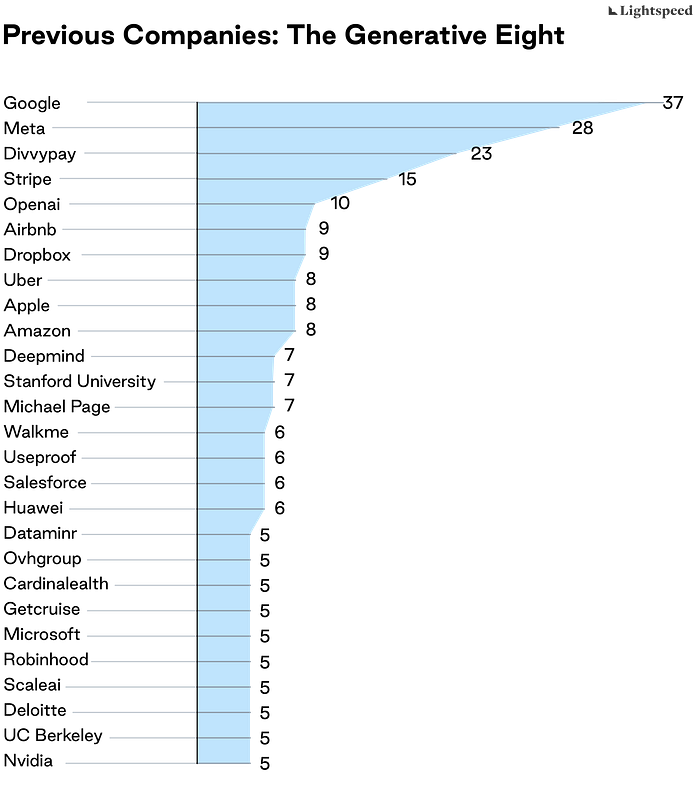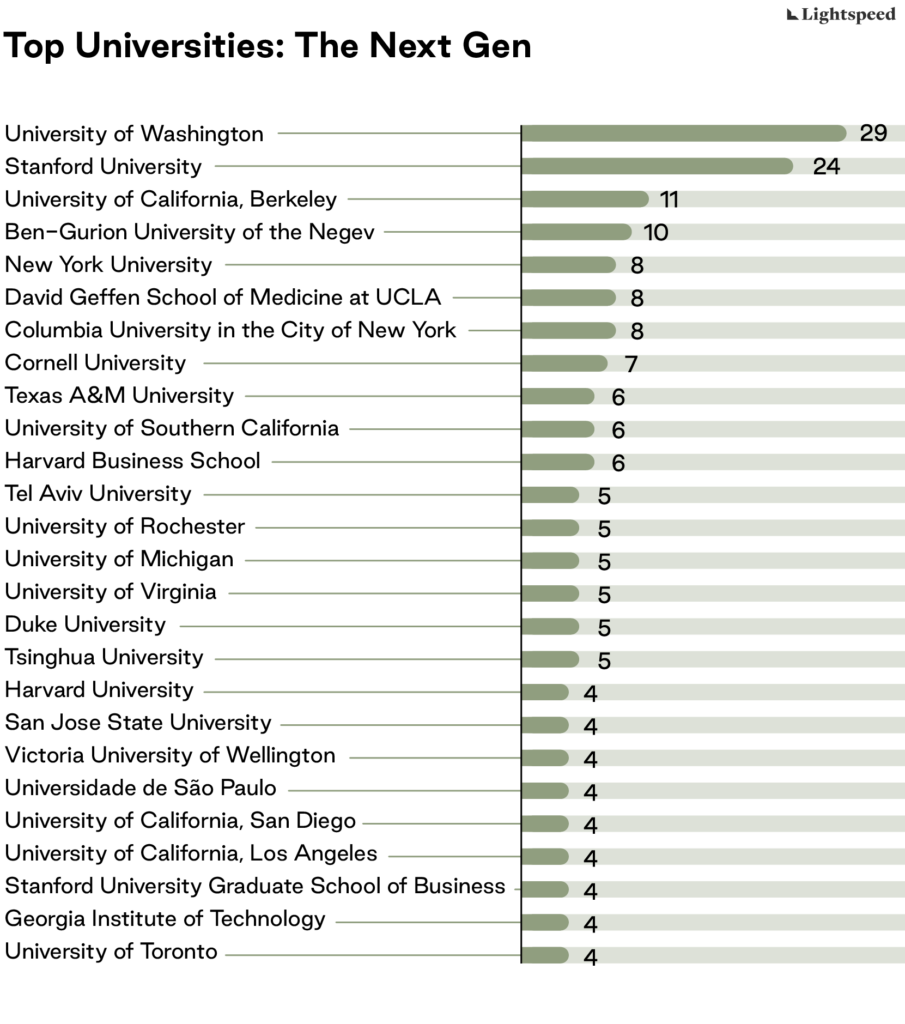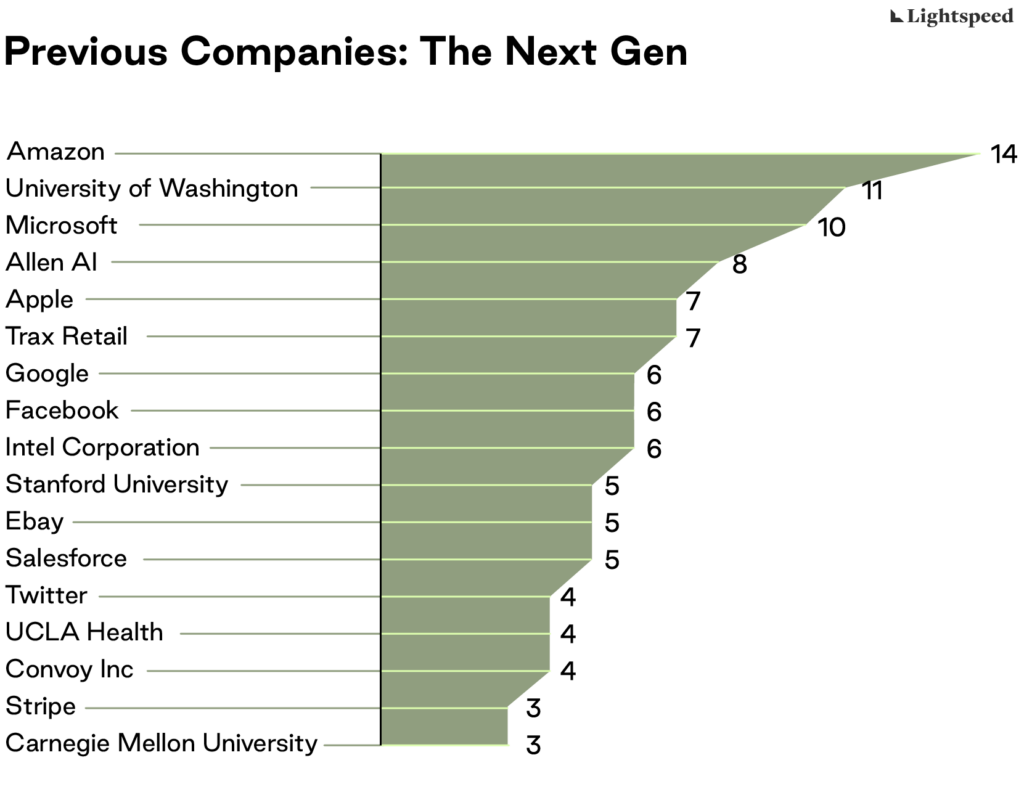07/12/2023
Spotlight
Eight AI Startups Winning the Race for Tech Talent
Meet the Generative Eight — and The Next Gen of AI companies building the future

Generative AI has taken the world by storm, and the companies building the future are in a race to hire the best available tech talent.
No technology has more rapidly changed humans’ relationship to their tools than the sci-fi fantasy brought to reality by OpenAI’s ChatGPT: Talking to a machine the way you’d talk to a colleague or friend, and getting valuable output from the interaction. Suddenly, it seems the only code one needs to know to make a computer do something novel is as simple as the English language. That’s true — almost magically so — but only to a point.
For the coders building the large language models, infrastructure, and supporting technology for AI applications, a new and specific set of hardcore technical skills and capabilities is necessary. And of course, experience counts — it takes deep knowledge and creativity to dream up some of the products reaching the market today. The engineers who know how to push the bounds of today’s AI technologies are the ones who’ve spent years perfecting them at some of the largest tech companies in the world.
The engineers who know how to push the bounds of today’s AI technologies are the ones who’ve spent years perfecting them at some of the largest tech companies in the world.
But, those large companies are for the most part playing catchup, as their top talent gets poached. There is a new crop of nimble, innovative AI companies — pure play startups with AI at their core. They are in a race for tech talent. At Lightspeed, we’ve been investing in AI for over seven years, and have been tracking this space for even longer.
This report is based on proprietary research and public data that identifies which AI firms are winning the race to hire the best technical talent, and breaks down where that talent is coming from. Let’s dive in.
AI Excitement
The pace of technological change keeps accelerating. From the automobile to the plane to the semiconductor, we’ve seen the power of innovation unleashed upon the globe. Generative AI is the kind of meta-technology that will, over time, reorganize the way nearly everything in our world functions and evolves, from farming to education to enterprise marketing to finance.
The companies that will define our future are being built today, in front of our very eyes, with technologies that anyone can read the source code to.
Exploiting this sea change requires one thing above all else: talent. Despite overblown fears that AI will replace all jobs with robots, there’s more demand than ever from generative AI startups for the kind of specialized skill sets needed to build new features and products. Not to mention managing all of the associated technology like running data centers holding thousands of GPUs crunching terabytes of training data. The work around LLMs has only just begun, as companies race to train bespoke models based on this technology, and refine those already out in the wild.
For that reason, stars on the Github projects where AI code lives is a useful analogue to track interest. And interest in AI projects — where anyone can contribute and learn how to create AI applications — has exploded, as seen in the chart below. The curve for OpenAI in particular gets steep right around the time of ChatGPT’s release to the public on November 30, 2022.
We can’t compare Github adoption curves to the transition from, say, stagecoaches to railroads, but by one account, the first passengers in the UK were carried on rail in 1825. By 1840 long-distance, horse-drawn coaches, which had dominated intercity travel since 1790, were obliterated. An industry that took 50 years to build only took 15 to creatively destroy and replace with superior technology.
It’s hard to imagine what computing will look like in 15 years, but the AI revolution is likely to be the fastest technology boom and transformation ever in human history.
How We Made This Report
At Lightspeed, we stack rank hundreds of millions of individuals and millions of companies based on publicly available self-reported employee information such as schooling, advanced degrees, prior companies, years of experience, patents, publications, and more, in order to identify companies with top technical talent.
For this analysis, we isolated data from over 3,500 companies working in the Generative AI space today. We filtered for companies with AI at their core, rather than companies layering AI onto existing applications — the companies creating the AI ecosystem. We also filtered for companies that have had notable funding rounds (with one exception). The data was normalized and equally weighted to generate our final rankings. We worked only with publicly available data — companies in stealth, or recently emerged, may have fit our criteria had their data been accessible. Geographical and headcount data is also affected by this factor, and all figures below, including headcount, are specific to a company’s technical/engineering employees only.
The Generative Eight
So, where are the leading purpose-built generative AI companies finding their talent? And who are those companies, exactly?
Our analysis led us to break the companies down into two distinct groups. First, The Generative Eight: The top eight pure-play AI companies when it comes to hiring talent.
These are the eight startups winning the race for tech talent. They’ve hired the highest caliber engineers and AI experts amongst their peers. They’ve found funding success and some level of product-market fit. And they will be the FAANGS of the future — proper nouns that inhabit our conversations and change our patterns of living.
Here are The Generative Eight — the top AI companies for talent, today:
- TOME — AI that helps generate presentations and visual narrative storytelling
- CHARACTER.AI — Create and chat with a variety of AI-generated personalities
- ANTHROPIC — An AI safety and research company, building chatbots for work environments
- OPENAI — The research firm that released ChatGPT, which demonstrates the power of large language models, and DALL-E for image generation
- HUGGING FACE — Building models to perform specific tasks in enterprise
- JASPER — Models that create marketing and brand level creative content
- STABILITY AI — Creators of Stable Diffusion, one of the first image generation models released to the public
- MIDJOURNEY — A self-funded research lab that has released a powerful image generation tool that runs entirely on Discord
These are the companies that are winning the race for tech talent, which is only intensifying. Here’s how their race is shaping up so far:
The Generative Eight’s tech talent is coming from leading companies across many technology sectors — which includes some employees who have already moved on from OpenAI, one of the oldest firms in the group.
Additionally, many Gen Eighters have come from Google, which was taken by surprise by the wide release of ChatGPT, and has been known to have invested heavily in AI research for many years — but with few visible applications or consumer-facing products or services, until recently.

The education background of tech talent at The Generative Eight is heavily weighted towards many recognizable names, but it also reflects an international aspect, with Canada’s University of Waterloo’s Artificial Intelligence Institute claiming fourth place and Belgium’s KU Leuven Institute for Artificial Intelligence taking the eighth spot.
Much has been made of “Cerebral Valley” — San Francisco’s Hayes Valley neighborhood, rechristened to reflect its status as a locus of AI events, meetups, and hacker houses. At the same time, San Francisco has had the worst COVID recovery of any major metropolitan area in the US. It appears that talent is flooding back into the city and the Bay Area (or at least finding new jobs with AI companies).
We weren’t able to track which employees in a given geographic area are remote workers (other than the 33 who specifically indicated so in data), but it’s safe to presume that Generative Eight employees abroad or in cities with low head counts are Zooming into a lot of calls. This data is also underreported, as some employees do not disclose their location.
The Next Gen
While the Generative Eight are claiming the outsize share of public attention, there’s another cohort Lightspeed identified in its research that is also attracting top quality talent to their teams. These 11 companies — The Next Gen — share a common attribute: while AI is at their core, like the Generative Eight, more of them are tackling problems in specific sectors or focused on particular use cases tailored to a real customer.
While many of the Generative Eight are poised to shape the future, and the leading edge of AI, the Next Gen could be the companies that will actually deliver the practical, applied interactions with AI tools that deliver outputs used in industries from healthcare to entertainment. We filtered our data set to only include companies with at least 10 employees and that had taken some external funding.
Here are The Next Gen companies pushing AI technology to practical applications:
- PICTOR LABS — Digital pathology (AI-powered histopathology) to accelerate clinical research on diseases
- ENDPOINT HEALTH — AI-assisted precision therapies for immune-related conditions
- OTTER.AI — AI powered audio transcription, with a new chatbot meeting assistant
- BRIA — Image and video content with commercial use controls
- WELLSAID LABS — Text to speech voice overs
- SUBTLE MEDICAL — AI powered image processing for radiology
- COPY.AI — Copywriting for marketing, via chatbot
- LEXION — AI contract assistant for sales, procurement, HR, legal, and more
- YOU — Search engine with a chatbot interface
- OCTOML — Cloud-based tuning and running for LLM models
- RUNWAY — Video, image, and other creative tools
These 11 companies are The Next Gen, and here is how their race for talent looks so far:
In 2021 the University of Washington was chosen to lead a new AI Institute in Dynamic Systems by the National Science Foundation, in addition to being the home of the Paul G. Allen School of Computer Science & Engineering, one of the leading AI research centers in the world, hence its place as a feeder for The Next Gen cohort:

When it comes to tracking prior employment, UW makes another appearance, along with Microsoft and the Allen Institute for AI, a research institute founded by the late Microsoft co-founder, Paul Allen. The Next Gen list companies Wellsaid, You, and Runway are all headquartered in Seattle:

Perhaps it’s no surprise that Seattle dominates The Next Gen list, given it’s home to several top tier companies and institutions that also covet AI talent.
In 2021 a Brookings Institution report listed “early-adopter” AI metro areas, naming “eight large tech hubs — New York; Boston; Seattle; Los Angeles; Washington, D.C.; San Diego; Austin, Texas; and Raleigh, N.C.” (This data is underreported, as some employees do not disclose their location.)
What’s next
According to Pitchbook, roughly $1.7 billion in deal value was generated in the AI space in Q1 2023. (Not including Microsoft’s $10 billion investment in Open AI, which was announced in January.)
Lightspeed continues to monitor and invest in companies at the forefront of the AI ecosystem, including recent investments in Tome, Stability AI, (both on The Generative Eight), Mistral, Contextual, Glean, Typeface, and many more. Our partners have published manifestos about the future of SaaS and Fintech in a world of AI, and there will be more to come.
Lightspeed is also hosting regular Generative meetups in New York, San Francisco, and Los Angeles, where we invite everyone building products that incorporate AI, and want to share their experiences with colleagues to join us. Sign up to be notified about the next events in these series.
Finally, if you’re building in the AI space, we’d love to hear from you. We’re a global, multi-stage, multi-sector firm investing in everything from seed to secondary and beyond. Learn more about us at lsvp.com.
Lightspeed is a VC firm focused on accelerating disruptive innovations and trends in the enterprise, consumer, and health sectors. Lightspeed has backed 600+ companies globally in the past two decades including Nutanix, Affirm, AppDynamics, MuleSoft, Snap and Nest.
Data: Radhika Mardikar, Eric Wayman, Jerry Ye
Graphics: Elsa Jenna / Palette
Text: Paul Smalera



